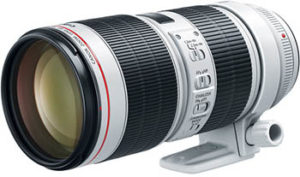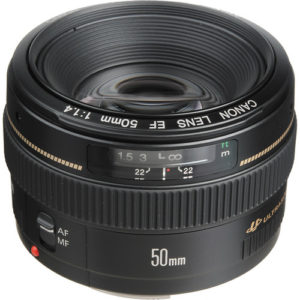Fixed vs Variable Aperture Lenses
Lenses are generally divided into amateur (variable) and professional (fixed), but it’s not that simple, it is more accurate to think of a “Quality Scale”. Yes, price is an indicator of quality, but you can get excellent quality lenses in the lower price range.
Most entry-level DSLR cameras today are sold with an 18-55mm f/3.5-f/5.6 kit lens, 20+ years ago they came with a 50mm f/1.8 lens. It’s a shame that they changed to the 18-55, as the 50mm is a fantastic lens. I understand they did it to keep the price down on the entry-level models, but I think they should educate people and give them a choice.
The 50mm f/1.8 lens made by both Nikon and Canon is the exception, due to great results from a cheaper build quality lens. Selling in the region $125-$130 the 50mm f/1.8 is a killer lens. The quality of the photographs and the bokeh (background blur) is amazing, it’s definitely a must-have lens. Buy one as soon as possible, you’ll be glad you did.
What is the Difference?
If you have an 18-55mm f/3.5-f/5.6 lens it has a variable aperture. The aperture varies between f/3.5 and f/5.6. At 18mm the aperture is f/3.5, and if you zoom in to 55mm the aperture will change to f/5.6.
- The lens body is generally lightweight plastic to keep costs down.
- Autofocus speed is slow, which is fine if you’re shooting a landscape, but capturing decent images of kids sports could be difficult.
- Not great in low light situations and need higher ISO settings (grainy).
- They are very capable and give pretty good results
- Compact and lightweight
A fixed aperture lens such as a Nikon 17-55mm f/2.8 allows you to keep the aperture at f/2.8 all the way through from 17mm to 55mm. An aperture of f/2.8 allows lots of light in and lets you shoot in low light conditions.
- Extremely well built
- Fast Autofocus
- Ideal for low light situations
- Excellent image quality
Is There A Difference in Price?
Yes, there is definitely a difference in the cost of these lenses. The 18-55mm f/3.5-f/5.6 kit lens is only available in a kit, so I’d estimate the value at approximately $100. While the Nikon 17-55mm f/2.8 sells for $1500 USD, professional lenses are expensive. Personally, I’d buy the 50mm f/1.8 and zoom with my feet.
Are All Professional Lenses Fixed Aperture?
No, there are some variable aperture lenses that can match the results of fixed aperture lenses in certain situations. The Canon L series of lenses are marketed to the pros and the Canon EF 28-300mm f/3.5-5.6L is in that L series and has a variable aperture. Early 2019 it cost $2449 USD, it’s aimed at professional travel photographers looking for a lightweight one-lens kit.
A few years ago I was considering shooting virtual tours for realtors. I went on a real estate photography forum asking questions and after a few discussions, I realized that I needed to get a variable aperture Canon 10-22mm f/3.5-4.5. The focal range of 10mm is really wide, wide enough for the smallest bathroom. The variable aperture didn’t matter because I would be using an off-camera flash to light the rooms. The image quality was excellent, very sharp. It wasn’t cheap at $650 USD but it was a tool I needed and it more than paid for itself.
What Lenses Do Professional Photographers Use?
Professionals use fixed aperture zoom and prime lenses, that offer superior optics, a better build, and sharp professional results.
Pro zooms have a range of focal lengths, 24-70mm, 16-35mm, 70-200mm, etc. with f/2.8 the widest aperture. The first time you use one of these lenses you will be blown away by the speed of the autofocus. The image quality is tack sharp which is what you want if you are shooting professionally.
Prime (primary) lenses have a fixed focal length, so no zooming. Available in many focal lengths, 10mm, 12mm, 24mm, 35mm, 40mm, 50mm, 60mm, 85mm, 100mm, 135mm, 200mm, 300mm, 400mm, 500mm, 600mm, and a few in between.
They are available with different apertures of f/1.2, f/1.4, f/1.8, f/2, f/2.8. Generally, the wider apertures (lower F numbers) are more expensive. The example below (priced 2019) shows the difference.
- Canon 85mm f/1.8 – $370
- Canon 85mm f/1.4 – $1600
- Canon 85mm f/1.2 – $1900
Don’t think of these three example lenses as the same with slightly different settings. Yes, they have the same focal length of 85mm, but the internal elements are different in each one. f/1.2 gives a totally different depth of field and bokeh to the f/1.4 and f/1.8 versions. These variations are important when you are shooting professionally.
My most frequently used lenses are the (Canon) 50mm f/1.4, 24-70mm f/2.8, and 70-200mm f/2.8. The zooms are heavy but you get used to them, the image quality is excellent. They have such a wide focal range I have most jobs covered. The 50mm f/1.4 is my favorite for portraits, it weighs next to nothing which is a plus when you’re carrying it around all day. The images I get with it are beautiful and the bokeh is incredible.
Should I buy Prime or Zoom Lenses?
That isn’t an easy question to answer. Do you want one lens that can shoot at different focal lengths or buy 2 or 3 primes that cover the same focal range? Is the heavyweight of a zoom lens a problem? Another factor is price, high-quality optics are really expensive. How much do you want to spend?
I bought my lenses as I needed them. My first lens was a Canon 70-200mm f/2.8, which I bought so I could shoot figure skating competitions. It was the perfect lens for the job. A prime 200mm or 300mm lens would not be as user-friendly as the zoom.
If you are going to shoot headshots/portraits, you could choose a prime lens like the 85mm f/1.8. But you could just as easily use a 70-200mm f/2.8 and zoom in to 85mm. There really isn’t a right answer. If you are just starting out and the cost is an issue, then the 85mm f/1.8 is going to be your first choice being approximately $1000 cheaper than the 70-200mm f/2.8.
The more genres ( Portraits, Weddings, Sports, Real Estate, etc.) you want to shoot the more lenses you will need. That is unless you can choose genres that use the same focal length lenses. This is where f/2.8 zooms start to shine and allow you to keep the lens count down.
When I used to shoot weddings my main lens was the 24-70mm f/2.8. If I was to start doing weddings again I would use 24mm, 50mm, and 85mm f/1.4 lenses. That’s because I absolutely love the look of photographs shot with f/1.4 primes. Carrying a zoom all day is tough on your back. Primes would be a pleasure to carry.
Are There Cheaper Lens Options?
Yes, there are cheaper options when buying lenses. If you shoot Canon you don’t have to purchase Canon lenses and that is the same for Nikon, Sony, etc. There are other manufacturers that make lenses that fit your camera bodies, such as Sigma, Tokina, and Tamron. You can save hundreds of dollars buying this way.
Make sure you go online and read reviews on lenses before purchasing them. Not all lenses in the Canon and Nikon ranges are incredible performers and the same goes for Sigma, Tokina, and Tamron. Lens (and camera) reviews are not only helpful in choosing the right equipment but you get an education too.
.


